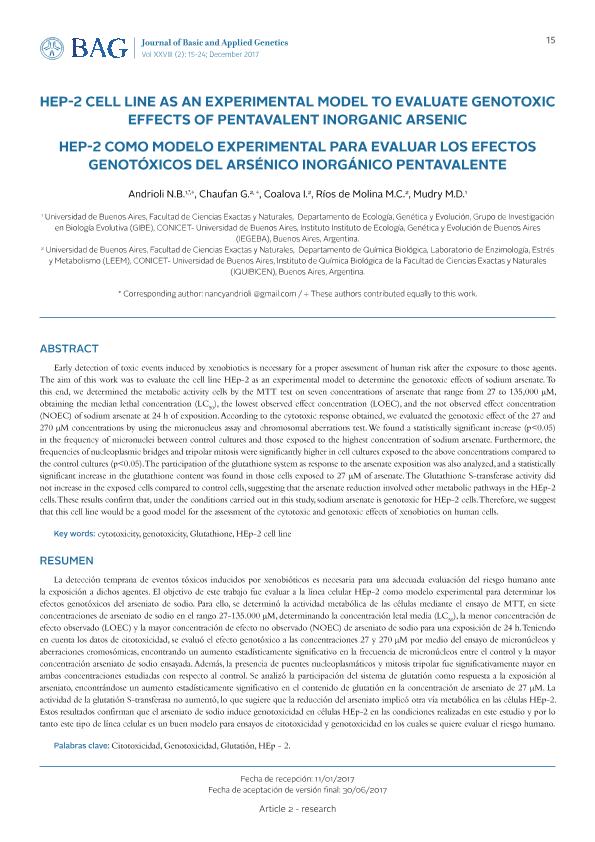Artículo
La detección temprana de eventos tóxicos inducidos por xenobióticos es necesaria para una adecuada evaluación del riesgo humano ante la exposición a dichos agentes. El objetivo de este trabajo fue evaluar a la línea celular HEp-2 como modelo experimental para determinar los efectos genotóxicos del arseniato de sodio. Para ello, se determinó la actividad metabólica de las células mediante el ensayo de MTT, en siete concentraciones de arseniato de sodio en el rango 27-135.000 μM, determinando la concentración letal media (LC50), la menor concentración de efecto observado (LOEC) y la mayor concentración de efecto no observado (NOEC) de arseniato de sodio para una exposición de 24 h. Teniendo en cuenta los datos de citotoxicidad, se evaluó el efecto genotóxico a las concentraciones 27 y 270 μM por medio del ensayo de micronúcleos y aberraciones cromosómicas, encontrando un aumento estadísticamente significativo en la frecuencia de micronúcleos entre el control y la mayor concentración arseniato de sodio ensayada. Además, la presencia de puentes nucleoplasmáticos y mitosis tripolar fue significativamente mayor en ambas concentraciones estudiadas con respecto al control. Se analizó la participación del sistema de glutatión como respuesta a la exposición al arseniato, encontrándose un aumento estadísticamente significativo en el contenido de glutatión en la concentración de arseniato de 27 μM. La actividad de la glutatión S-transferasa no aumentó, lo que sugiere que la reducción del arseniato implicó otra vía metabólica en las células HEp-2. Estos resultados confirman que el arseniato de sodio induce genotoxicidad en células HEp-2 en las condiciones realizadas en este estudio y por lo tanto este tipo de línea celular es un buen modelo para ensayos de citotoxicidad y genotoxicidad en los cuales se quiere evaluar el riesgo humano. Early detection of toxic events induced by xenobiotics is necessary for a proper assessment of human risk after the exposure to those agents. The aim of this work was to evaluate the cell line HEp-2 as an experimental model to determine the genotoxic effects of sodium arsenate. To this end, we determined the metabolic activity cells by the MTT test on seven concentrations of arsenate that range from 27 to 135,000 μM, obtaining the median lethal concentration (LC50), the lowest observed effect concentration (LOEC), and the not observed effect concentration (NOEC) of sodium arsenate at 24 h of exposition. According to the cytotoxic response obtained, we evaluated the genotoxic effect of the 27 and 270 μM concentrations by using the micronucleus assay and chromosomal aberrations test. We found a statistically significant increase (p<0.05) in the frequency of micronuclei between control cultures and those exposed to the highest concentration of sodium arsenate. Furthermore, the frequencies of nucleoplasmic bridges and tripolar mitosis were significantly higher in cell cultures exposed to the above concentrations compared to the control cultures (p<0.05). The participation of the glutathione system as response to the arsenate exposition was also analyzed, and a statistically significant increase in the glutathione content was found in those cells exposed to 27 μM of arsenate. The Glutathione S-transferase activity did not increase in the exposed cells compared to control cells, suggesting that the arsenate reduction involved other metabolic pathways in the HEp-2 cells. These results confirm that, under the conditions carried out in this study, sodium arsenate is genotoxic for HEp-2 cells. Therefore, we suggest that this cell line would be a good model for the assessment of the cytotoxic and genotoxic effects of xenobiotics on human cells.
HEp-2 cell line as an experimental model to evaluate genotoxic effects of pentavalent inorganic arsenic
Título:
HEp-2 como modelo experimental para evaluar los efectos genotóxicos del arsénico inorgánico pentavalente
Andrioli, Nancy Beatriz; Chaufan, Gabriela ; Coalova, Isis
; Coalova, Isis ; Molina, María del Carmen
; Molina, María del Carmen ; Mudry, Marta Dolores
; Mudry, Marta Dolores
 ; Coalova, Isis
; Coalova, Isis ; Molina, María del Carmen
; Molina, María del Carmen ; Mudry, Marta Dolores
; Mudry, Marta Dolores
Fecha de publicación:
12/2017
Editorial:
Sociedad Argenitna de Genética
Revista:
BAG
ISSN:
1666-0390
e-ISSN:
1852-6233
Idioma:
Inglés
Tipo de recurso:
Artículo publicado
Clasificación temática:
Resumen
Palabras clave:
Citotoxicidad
,
Genotoxicidad
,
Glutatión
,
Hep-2 Cell Line
Archivos asociados
Licencia
Identificadores
Colecciones
Articulos(IEGEBA)
Articulos de INSTITUTO DE ECOLOGIA, GENETICA Y EVOLUCION DE BS. AS
Articulos de INSTITUTO DE ECOLOGIA, GENETICA Y EVOLUCION DE BS. AS
Articulos(IQUIBICEN)
Articulos de INSTITUTO DE QUIMICA BIOLOGICA DE LA FACULTAD DE CS. EXACTAS Y NATURALES
Articulos de INSTITUTO DE QUIMICA BIOLOGICA DE LA FACULTAD DE CS. EXACTAS Y NATURALES
Citación
Andrioli, Nancy Beatriz; Chaufan, Gabriela; Coalova, Isis; Molina, María del Carmen; Mudry, Marta Dolores; HEp-2 cell line as an experimental model to evaluate genotoxic effects of pentavalent inorganic arsenic; Sociedad Argenitna de Genética; BAG; XXVIII; 2; 12-2017; 15-24
Compartir



